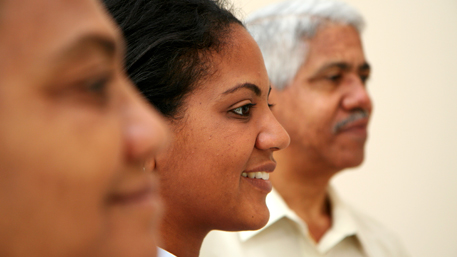 Spotlight
Spotlight
Training Institute for Dissemination and Implementation Research in Genomics and Precision Public Health (TIDIR-GPPH) Facilitated Course
(Posted Jul 24, 2024 8AM)
Advancing Genomic Cancer Medicine in Rural and Underserved States
(Posted Jul 22, 2024 10AM)
Equity in action: The Diagnostic Working Group of The Undiagnosed Diseases Network International
(Posted Jul 05, 2024 9AM)
Implications of Provider Specialty, Test Type, and Demographic Factors on Genetic Testing Outcomes for Patients with Autism Spectrum Disorder
(Posted Jun 18, 2024 4PM)
 Latest News and Publications
Latest News and Publications
Jiangliu Yilan, et al. Applied clinical informatics 2024 0 0.
Lessons learned from a multi-site collaborative working toward a digital health use screening tool.
Hernandez Ann M, et al. Frontiers in public health 2024 0 0. 1421129
Factors Associated With Surveillance Testing in Individuals With COVID-19 Symptoms During the Last Leg of the Pandemic: Multivariable Regression Analysis.
Dotson Timothy, et al. JMIR public health and surveillance 2024 0 0. e52762
A Multimorbidity Analysis of Hospitalized Patients With COVID-19 in Northwest Italy: Longitudinal Study Using Evolutionary Machine Learning and Health Administrative Data.
Benny Dayana, et al. JMIR public health and surveillance 2024 0 0. e52353
Assessing the Relationship Between Neighborhood Socioeconomic Disadvantage and Telemedicine Use Among Patients With Breast Cancer and Examining Differential Provisions of Oncology Services Between Telehealth and In-Person Visits: Quantitative Study.
Freeman Jincong Q, et al. JMIR cancer 2024 0 0. e55438
COVID-19 Across Pandemic Variant Periods: The Severe Acute Respiratory Infection-Preparedness (SARI-PREP) Study.
Mukherjee Vikramjit, et al. Critical care explorations 2024 0 0. (7) e1122
Household income unequally affects genetic susceptibility to pulmonary diseases: evidence from bidirectional Mendelian randomization study.
Xu Hongfa, et al. Frontiers in medicine 2024 0 0. 1279697
Surveillance of adverse events following immunisation in Australia annual report, 2021.
Imai Chisato, et al. Communicable diseases intelligence (2018) 2024 0 0.
Impact of class cancellations on parents' and children' adaptation following an outbreak of the Omicron variant during the COVID-19 pandemic in Taiwan in April 2022.
Chao Kuo-Yu, et al. BMC public health 2024 0 0. (1) 1902
Nonrepresentativeness of Human Mobility Data and its Impact on Modeling Dynamics of the COVID-19 Pandemic: Systematic Evaluation.
Liu Chuchu, et al. JMIR formative research 2024 0 0. e55013
Risk-reducing salpingo-oophorectomy among diverse patients with BRCA mutations at an urban public hospital: a mixed methods study.
Alexandra J Lamacki et al. BMJ Open 2024 14(6) e082608
The role of socio-economic disparities in the relative success and persistence of SARS-CoV-2 variants in New York City in early 2021.
Tetyana I Vasylyeva et al. PLoS Pathog 2024 6 (6) e1012288
A Paper-Based Multiplexed Serological Test to Monitor Immunity against SARS-COV-2 Using Machine Learning.
Eryilmaz Merve, et al. ACS nano 2024 0 0.
Assessing fairness in machine learning models: A study of racial bias using matched counterparts in mortality prediction for patients with chronic diseases.
Yifei Wana et al. J Biomed Inform 2024 104677
Digital pathology, deep learning, and cancer: a narrative review.
Darnell K Adrian Williams et al. Transl Cancer Res 2024 13(5) 2544-2560
An ethical assessment of professional opinions on concerns, chances, and limitations of the implementation of an artificial intelligence-based technology into the geriatric patient treatment and continuity of care.
Nina Parchmann et al. Geroscience 2024
Results from the Delivery of a Community Health Worker Training to Advance Competencies in Cancer Genomics.
Caitlin G Allen et al. Public Health Genomics 2024
Artificial Intelligence in the Provision of Health Care: An American College of Physicians Policy Position Paper.
Nadia Daneshvar et al. Ann Intern Med 2024
Equity and AI governance at academic medical centers.
Paige Nong et al. Am J Manag Care 2024 30(6 Spec No.) SP468-SP472
The impact of health inequity on spatial variation of COVID-19 transmission in England.
Rawson Thomas, et al. PLoS computational biology 2024 0 0. (5) e1012141
More
About Health Equity PHGKB
Health Equity PHGKB is an online, continuously updated, searchable database of genomics and precision health information and publications relevant to health equity...more
Content Summary
Disclaimer: Articles listed in the Public Health Knowledge Base are selected by Public Health Genomics Branch to provide current awareness of the literature and news. Inclusion in the update does not necessarily represent the views of the Centers for Disease Control and Prevention nor does it imply endorsement of the article's methods or findings. CDC and DHHS assume no responsibility for the factual accuracy of the items presented. The selection, omission, or content of items does not imply any endorsement or other position taken by CDC or DHHS. Opinion, findings and conclusions expressed by the original authors of items included in the update, or persons quoted therein, are strictly their own and are in no way meant to represent the opinion or views of CDC or DHHS. References to publications, news sources, and non-CDC Websites are provided solely for informational purposes and do not imply endorsement by CDC or DHHS.
- Page last reviewed:Feb 1, 2024
- Content source:


